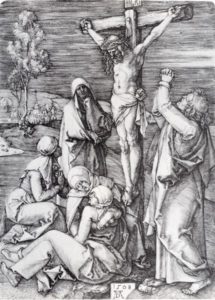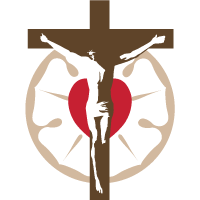by Dcs. Carolyn Brinkley
 Powerful, intriguing, and terrifying! The Four Horseman woodcut is from Albrecht Dürer’s Apocalypse series published in Nuremberg in 1511. The scene evokes a feeling of unstoppable devastation. It is almost as if the surging horses will leap from the printed page and the viewer will be caught in their path of destruction ending in the heap of trampled bodies.
Powerful, intriguing, and terrifying! The Four Horseman woodcut is from Albrecht Dürer’s Apocalypse series published in Nuremberg in 1511. The scene evokes a feeling of unstoppable devastation. It is almost as if the surging horses will leap from the printed page and the viewer will be caught in their path of destruction ending in the heap of trampled bodies.
But what does it mean? We go to Scripture. Dürer gives a visual dimension to the words of Revelation 6:1-8. It is the disturbing and frightening scene of man’s inhumanity to man. It is the result of the sin of not loving our neighbor as God commands. It leads to death.
The first rider is in the act of shooting a bow. His victory is symbolized by the white color of the horse. However, the conquest does not bring peace, but rather the tyranny of mankind ruling over his brother. The awful effects of this sin have dominated every generation since the Garden of Eden and can be seen in every realm of society from government to the family.
Scripture tells us that the second horse is bright red. It is the color of bloodshed. The horseman wields a mighty sword. The tyranny seen in the first horseman leads to the large scale lust for dominance of nation against nation bringing the evils of war. Interestingly Dürer presents the first two riders in Turkish hats as the Turks were the feared enemy invaders of his day.
Dürer places the third rider and his black horse dead center in the woodcut. He swings his scales for measuring food as though it were a weapon. Some would say that this is a picture of famine that results from war portrayed by the second horseman, but it also shows economic imbalance caused by man’s greed. While many are starving, “a quart of wheat for a denarius” (a day’s wage for a laborer) the horseman is well dressed and hearty, “and do not harm the oil and the wine!” (v.6)
 The fourth horseman is emaciated. He rakes his prey with a pitchfork. The horse is the pale ghastly color of a corpse. “Its rider’s name was Death.” (v.8) This is the inevitable result of the first three riders. Death and Hades form a unit. The artist pictures a religious official being sucked into the dragon’s mouth. An ordinary Renaissance woman is next to succumb to the jaw’s of death, followed by others who had been trampled. There is no escape!
The fourth horseman is emaciated. He rakes his prey with a pitchfork. The horse is the pale ghastly color of a corpse. “Its rider’s name was Death.” (v.8) This is the inevitable result of the first three riders. Death and Hades form a unit. The artist pictures a religious official being sucked into the dragon’s mouth. An ordinary Renaissance woman is next to succumb to the jaw’s of death, followed by others who had been trampled. There is no escape!
Not a pretty picture! But yet there is hope. The entire sky is resplendent with the Gospel! Dürer liberally uses the Renaissance icon of clouds symbolizing the presence of God. Rays from His nimbus/halo can be seen in the upper left corner. The angel of the Lord hovers over the entire scene with comfort. The left hand touches the sword showing that although the destruction is broad and sweeping, yet God controls and limits. “And they were given authority over one fourth of the earth.” (v. 8) The right hand of the angel is in blessing. The evil of sin will continue to the end of time, but God will not abandon His children. How do we know? It is the victorious Lamb who opens the scroll and gives this vision to St. John and to us. We are safe in Christ! Through His death we live and reign with Him now and forever!
 Worthy are you to take the scroll and to open its seals,
Worthy are you to take the scroll and to open its seals,
For You were slain and by Your blood You have ransomed people for God
From every tribe and language and people and nation,
And You have made them a kingdom and priests to our God,
And they shall reign on the earth. (Revelation 5:9-10)
Deaconess Carolyn S. Brinkley is the Military Project Coordinator at Concordia Theological Seminary, Fort Wayne, Ind.
